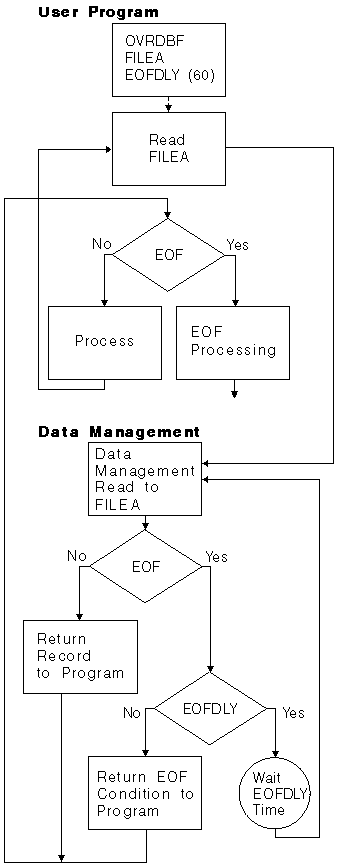End-of-file delay is a method of continuing to read sequentially from a database file (logical or physical) after an end-of-file condition occurs.
When an end-of-file condition occurs on a file being read sequentially (for example, next/previous record) and you have specified an end-of-file delay time (EOFDLY parameter on the Override with Database File (OVRDBF) command), the system waits for the time you specified.
At the end of the delay time, another read is done to determine if any new records were added to the file. If records were added, normal record processing is done until an end-of-file condition occurs again. If records were not added to the file, the system waits again for the time specified. Special consideration should be taken when using end-of-file delay on a logical file with select/omit specifications, opened so that the keyed sequence access path is not used. In this case, after end-of-file is reached, the system retrieves only those records added to a based-on physical file that meet the select/omit specifications of the logical file.
Also, special consideration should be taken when using end-of-file delay on a file with a keyed sequence access path, opened so that the keyed sequence access path is used. In this case, after end-of-file is reached, the system retrieves only those records added to the file or those records updated in the file that meet the specification of the read operation using the keyed sequence access path.
For example, end-of-file delay is used on a keyed file that has a numeric key field in ascending order. An application program reads the records in the file using the keyed sequence access path. The application program performs a read next operation and gets a record that has a key value of 99. The application program performs another read next and no more records are found in the file, so the system attempts to read the file again after the specified end-of-file delay time. If a record is added to the file or a record is updated, and the record has a key value less than 99, the system does not retrieve the record. If a record is added to the file or a record is updated and the record has a key value greater than or equal to 99, the system retrieves the record.
For end-of-file delay times equal to or greater than 10 seconds, the job is eligible to be removed from main storage during the wait time. If you do not want the job eligible to be moved from main storage, specify PURGE(*NO) on the Create Class (CRTCLS) command for the CLASS the job is using.
To indicate which jobs have an end-of-file delay in progress, the status field of the Work with Active Jobs (WRKACTJOB) display shows an end-of-file wait or end-of-file activity level for jobs that are waiting for a record.
If a job uses end-of-file-delay and commitment control, it can hold its record locks for a longer period of time. This increases the chances that some other job can try to access those same records and be locked out. For that reason, be careful when using end-of-file-delay and commitment control in the same job.
If a file is shared, the OVRDBF command specifying an end-of-file delay must be requested before the first open of the file because overrides are ignored that are specified after the shared file is opened.
- Write a record to the file with the end-of-file-delay that will be recognized by the application program as a last record. The application program can then specify a force-end-of-data (FEOD) operation. An FEOD operation allows the program to complete normal end-of-file processing.
- Do a controlled end of a job by specifying OPTION(*CNTRLD) on the End Job (ENDJOB) command, with a DELAY parameter value time greater than the EOFDLY time. The DELAY parameter time specified must allow time for the EOFDLY time to run out, time to process any new records that have been put in the file, and any end-of-file processing required in your application. After new records are processed, the system signals end of file, and a normal end-of-file condition occurs.
- Specify OPTION(*IMMED) on the ENDJOB command. No end-of-file processing is done.
- If the job is interactive, press the System Request key to end the last request.
The following example shows an end-of-file delay operation:

The actual processing of the EOFDLY parameter is more complex than shown because it is possible to force a true end-of-file if OPTION(*CNTRLD) on the ENDJOB command is used with a long delay time.